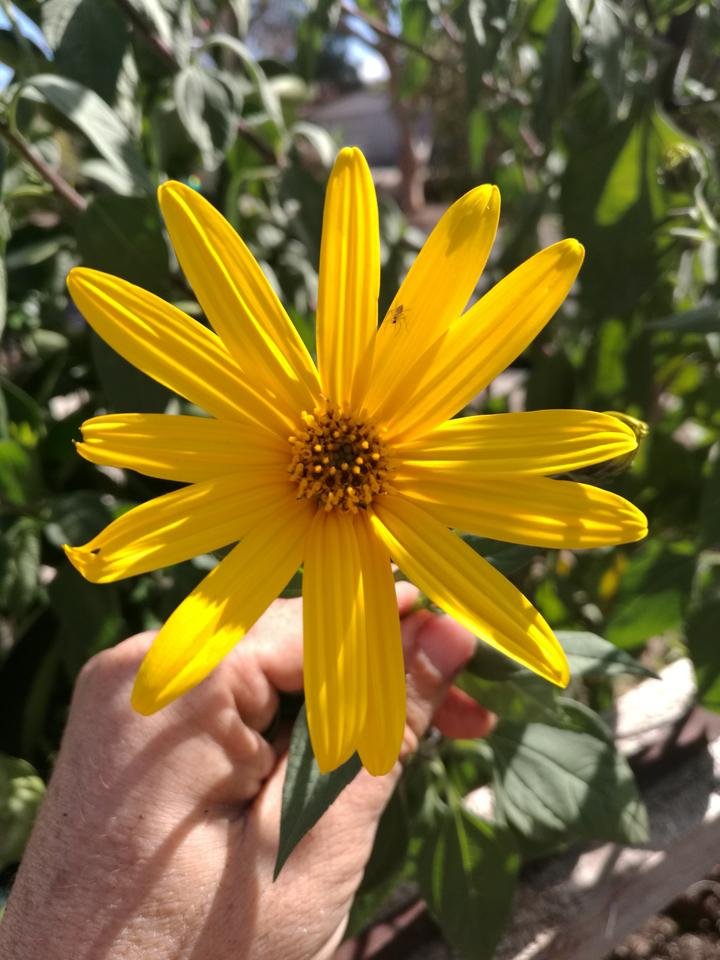
Jerusalem Artichokes (Helianthus tuberosus) are a close relative of the well known Sunflower (Helianthus annuus). They are equally as tall, hardy and beautiful as their cousins and even more productive.
This plant has many names, the most descriptive being 'Sunchokes' or 'Fartichokes'.
I call Jerusalem Artichokes 'everyone's best friend' because they have so many uses in a homesteader's, prepper's or permaculturalist's garden.
First, they are tasty and nutritious. They have direct health benefits. Jerusalem Artichokes store their energy as Inulin instead of sugars, that means they are a must for many diabetics.
Inulin is one of the favourite foods for our gut bacteria, which thrive on it. The happier they are, the healthier we are too!
While on the subject of food, Sunchokes have one little teensy-tiny drawback. They make you produce and pass prodigious quantities of foul wind. That is where one of their nicknames comes from...'fartichokes'.It's pretty obvious where that come from.
There are reputed remedies such as eating fennel with your fartichokes. That isn't too bad, they taste great together too. Realistically though, I find that this 'phenomenon', for want of a better word, only occurs for the first couple of meals of the season, then it,settles down. There are those who would disagree with me though!

Secondly, they are so productive. Take a look at the mass of tubers that I dug up last year. That's from just three planted tubers! I got more than 2 kg and left a lot in the ground for this year.
The best time to harvest is in Winter, when the above ground parts have died back. The thick stalks will stay so that you can cut them and use them as garden stakes.
That brings up another strength. Once you have Jerusalem Artichokes you will never be without them. They will regrow from a small part of a tuber left in the ground, or from peelings in your kitchen scraps. It's best to plant them in an area where they can be wrangled easily.
What more can these things offer?
Once in the ground, you hardly have to water them. If you live in an area where you get a little rain all year, that 'hardly' turns to 'never'. Of course, a little TLC will give you bigger tubers.

Their rapid growth is an advantage when you want to quickly shade an area, such as a window in full Sun or more delicate plants. Ours regularly top three metres in a couple of months.
The size of the leaves and their dense pattern can block a lot of sunlight too.
Lastly, the beautiful flowers attract while swarms of pollinators and predators. Strategic planting means that other plants can benefit from the presence of these insects.
The flowers can be sacrificed in favour of larger tubers. Cutting the flower buds before they open saves energy in the plant that can be redirected to storage.
One thing we do at Ligaya is to have a little patch between the fruit trees. The height of the Sunchoke flowers delivers predators and pollinators straight into the fruit growing zone, ready for action where they're most needed.
What do you reckon then? Aren't Jerusalem Artichokes one of the best plants to have in your food garden?
Oh yeah! Jelina just reminded me, the best way to cook them is roasting with fennel and other tubers such as carrots and potatoes. They have a starchy, nutty taste that is just divine.


This is #originalwork. The pics were taken by yours truly.
There is an index of Edible Weeds posts that I've done here on Steemit.
Find out more about edible weeds on our blog, Ligaya.
We also have a YouTube channel and a Patreon page that you might like to visit.


Community Forums
We're also members of the Homesteadersonline community. Click the image for the invite link to join us


Thats very usefull info, i like the fact that is high in innulin.
It is importNt, isnt it? I made a joke once about beingknowing who the local diabetics are by the amount they fart. Thats because after attending one of my tslks, a few of the locals switched to sunchokes as a big part of their diet.
Congratulations! This post has been added to our growing directory of Steemit "how to" posts for the Homesteading/Survival/Foraging/Prepper communities. If you haven't done so already, you can claim your badge along with the code to add to your posts to let the world know you have chosen to help others Survive, Thrive and be Prepared! Click here to get the code
Thank you! Can I add this to all posts to promote SOTALL or just those that are included?
Cool! So do these things produce seeds like sunflowers? And the name is throwing me off, is this plant and sunflowers related to the artichoke plant?
The name is confusing. Its not related to Artichokes at all and has nothing to do with Jerusalem either! Thats why I always go by the taxonomic name because common names are so confusing.
They dont produce seeds like Sunflowers which is a pity. If they did they would be incredibly useful.
Thanks for the info! Also thanks for teaching me something new! Well done post👍
How do you harvest them? And when is the best time?
I should have included that in the post...thanks for the reminder! You can harvest anytime from plants but the best is to harvest towards winter when the above ground section dies back. You can use the stalks as garden stakes.
Thanks I should try these!
Your Post Has Been Featured on @Resteemable!
Feature any Steemit post using resteemit.com!
How It Works:
1. Take Any Steemit URL
2. Erase
https://3. Type
reGet Featured Instantly & Featured Posts are voted every 2.4hrs
Join the Curation Team Here | Vote Resteemable for Witness
Congratulations @ligayagardener! You have completed some achievement on Steemit and have been rewarded with new badge(s) :
Click on any badge to view your own Board of Honor on SteemitBoard.
For more information about SteemitBoard, click here
If you no longer want to receive notifications, reply to this comment with the word
STOPDo not miss the last announcement from @steemitboard!